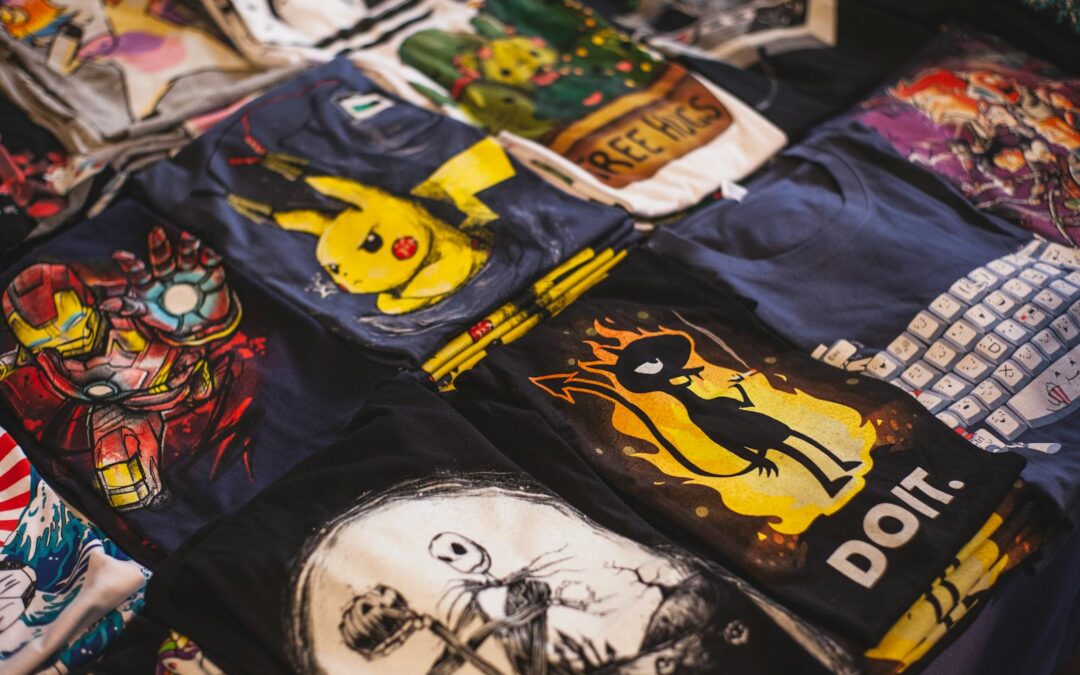Have you found yourself at a crossroads in the textile world, torn between choosing polyester vs cotton for your next Direct-to-Fabric (DTF) transfer project? You’re not alone.
The debate between polyester and cotton is a hot topic among DIY crafters, textile enthusiasts, and small business owners. In this comprehensive guide, we’ll explore the key differences between these two popular fabrics, focusing on their unique properties, benefits, and drawbacks.
Whether you’re new to the world of fabrics or looking to refine your skills, this article will provide valuable insights to help you make an informed decision.

Understanding Polyester and Cotton | A Deep Dive
Polyester and cotton are two of the most widely used fabrics in the world, each boasting distinct qualities and applications. Polyester fibers, a synthetic fabric material derived from petroleum, is celebrated for its durability, wrinkle resistance, and quick-drying capabilities.
On the other hand, cotton fibers, a natural fiber harvested from the cotton plant, is renowned for its softness, breathability, and eco-friendly attributes.
Understanding the fundamental differences between both cotton and polyester fabrics is crucial, as it influences factors like comfort, maintenance, and suitability for various projects.
In this guide, we will delve into the characteristics that set polyester and cotton apart, equipping you with the knowledge to choose the perfect, popular fabric for your DTF transfer endeavors.
The Chemical Makeup
Polyester is a synthetic fiber made from polyethylene terephthalate (PET), a type of plastic. The production process involves melting PET pellets and extruding them through spinnerets to form long threads. These threads are then woven into fabric.
On the other hand, cotton is a natural fiber harvested from the seed pods of the cotton plant. The fibers are spun into yarn and then woven into fabric. These two most common fabrics have very different properties when it comes to the chemical makeup.
Production Process
The manufacture of polyester fabric is relatively quick and low-cost, making it a popular choice for many applications. However, it relies heavily on non-renewable resources like petroleum and natural gas. There is no real pure polyester like their is cotton fabric.
Cotton production, while more labor-intensive and time-consuming, is a renewable resource. Organic cotton, which avoids synthetic pesticides and fertilizers, is gaining popularity for its sustainability.
Environmental Impact
Both polyester and cotton have significant environmental footprints. Polyester production generates greenhouse gases and relies on fossil fuels, making it less eco-friendly.
Cotton cultivation, particularly conventional cotton, requires large amounts of water and pesticides. However, organic cotton offers a more sustainable alternative, although it still demands substantial water resources.

Polyester vs Cotton | Performance and Durability
Choosing the right fabric for your project isn’t just about aesthetics; it’s also about functionality, durability, and overall performance. In this section, we will examine the performance and durability of polyester and cotton, highlighting how each fabric stands up under various conditions.
From color retention and resistance to wear and tear, to how well each fabric holds up after multiple washes, understanding these factors can be critical in making the best choice for your DTF transfer projects. Let’s dive into the specifics of performance and durability for both polyester and cotton.
Breathability and Moisture Wicking
Polyester excels in moisture-wicking properties, making it a favorite for athletic wear and outdoor clothing. It quickly draws sweat away from the skin, keeping you dry during intense activities.
Cotton, while incredibly soft and breathable, tends to absorb moisture, making it less ideal for sweaty conditions.
Insulating Properties
When it comes to insulation, both fabrics have their strengths. Polyester traps heat effectively, making it suitable for colder climates. Cotton, on the other hand, offers better ventilation, making it a popular choice for summer clothing. Both fabrics are versatile, but their performance varies depending on the weather conditions.
Durability and Wear
Polyester is renowned for its durability and resistance to wear and tear. It’s less likely to shrink, wrinkle, or fade over time, making it a low-maintenance option.
Cotton, while durable, is more prone to shrinking and wrinkling. However, high-quality cotton, like Sea Island Cotton, offers exceptional durability and maintains its softness even after multiple washes.

Polyester vs Cotton | Comfort and Aesthetics
When selecting fabric for your DTF transfer projects, comfort and aesthetics play a pivotal role. The tactile experience of a fabric, how it feels against the skin, and its visual appeal can significantly influence your choice.
In this section, we will delve into the comfort levels and aesthetic attributes of both polyester and cotton. By understanding how these fabrics perform in terms of softness, flexibility, and visual appearance, you can ensure that your creations not only look great but also offer the desired level of comfort for the end user.
Feel Against the Skin
When it comes to comfort, cotton is often the go-to choice. Its natural fibers are soft and gentle against the skin, reducing the risk of irritation.
Polyester, although smooth, can sometimes cause static electricity and may feel less luxurious.
Aesthetic Qualities
Both polyester and cotton offer unique aesthetic qualities. Polyester is versatile and can be engineered to mimic various textures and finishes, making it suitable for different types of clothing.
Cotton’s natural look and feel make it ideal for casual wear and items that require a softer touch.
Suitability for Different Clothing Types
Polyester is often used in sportswear, outdoor gear, and items that require durability and quick-drying properties.
Cotton is commonly found in t-shirts, flannel shirts, and other everyday clothing items. Each fabric has its place, and the choice often depends on the specific needs of the garment.

Polyester vs Cotton | Environmental Considerations
When making fabric choices for your DTF transfer projects, it’s essential to consider the environmental impact of each option. The lifecycle of polyester and cotton—from production to disposal—can have significant effects on natural resources and ecosystems.
In this section, we will explore the environmental implications of both fabrics in greater detail, highlighting their sustainability profiles, the resources they require, and their long-term effects on our planet. Our goal is to provide you with a comprehensive understanding of how your fabric choices can contribute to more sustainable and eco-friendly practices.
Biodegradability and Recycling
One of the significant differences between polyester and cotton is their biodegradability. Cotton is a natural fiber and decomposes relatively quickly, making it more environmentally friendly.
Polyester, being a synthetic fiber, takes hundreds of years to break down. However, recycled polyester is becoming increasingly popular, offering a more sustainable option.
Role of Synthetic vs. Natural Fibers
The debate between synthetic and natural fibers extends beyond just polyester and cotton. Synthetic fibers like polyester are durable and versatile but have a significant environmental impact.
Natural fibers like cotton are renewable and biodegradable but require substantial resources. Balancing these factors is crucial for sustainability.
Sustainability in the Textile World
Sustainability is a growing concern in the textile industry. Innovations in production methods, recycling, and the use of organic materials are steps toward reducing the environmental footprint of both polyester and cotton fabrics.
Making informed choices about the fabrics you use can contribute to a more sustainable future.

Polyester vs Cotton | Health and Allergen Considerations
When choosing fabrics for your DTF transfer projects, it’s crucial to consider the health and allergen implications for the end users. Different materials can have varying effects on skin health and allergic reactions, which can impact the overall comfort and safety of the garment.
In this section, we will explore how polyester and cotton fare in terms of hypoallergenic properties, skin sensitivity, and chemical treatments. By understanding these factors, you can make more informed decisions that prioritize the well-being of those who will wear your creations.
Interaction with Sensitive Skin
For individuals with sensitive skin, fabric choice is critical. Cotton is hypoallergenic and less likely to cause skin irritation, making it ideal for those with sensitive skin.
Polyester, while generally safe, can sometimes cause skin reactions, especially in individuals prone to allergies.
Allergic Reactions
Allergic reactions to fabrics are rare but possible. Cotton, being a natural fiber, is less likely to cause allergies. Polyester, a synthetic material, may contain chemicals that can trigger allergic reactions in sensitive individuals.
It’s essential to consider these factors when choosing fabrics for clothing, especially for children and those with skin conditions.
Health Benefits
Choosing the right fabric can have health benefits beyond just avoiding allergies. Cotton’s breathability and moisture-absorbing properties make it comfortable to wear, reducing the risk of skin infections.
Polyester, with its moisture-wicking abilities, helps keep the skin dry, preventing chafing and discomfort during physical activities.

Polyester vs Cotton | Practical Application DTF Transfers
Direct-to-Film (DTF) transfers offer a versatile and innovative approach to applying designs to various fabrics. This method, known for its precision and durability, allows enthusiasts and professionals alike to create high-quality, customized apparel.
In this section, we will cover the practical steps and considerations necessary for successful DTF transfers, from selecting appropriate fabrics to mastering the transfer process. By understanding the techniques and tools required, you can ensure that your DTF projects not only look professional but also stand the test of time.
Response to DTF Transfers
Direct-to-Fabric (DTF) transfers have unique requirements, and the fabric choice can significantly impact the final result. Polyester’s smooth surface and durability make it an excellent candidate for DTF transfers.
It holds the ink well and provides vibrant, long-lasting prints. Cotton, while also suitable for DTF, may require pre-treatment to ensure the best results.
Tips for Choosing the Right Fabric
When selecting a fabric for DTF transfers, consider the intended use of the final product. For sportswear and outdoor gear, polyester’s durability and moisture-wicking properties make it a top choice.
For everyday clothing and items requiring a softer touch, cotton is ideal. Experimenting with both fabrics can help you determine the best fit for your projects.

Where to Buy Polyester Fabrics
Finding high-quality polyester fabrics for your DTF transfer projects is crucial for achieving the best results.
Below is a list of reputable vendors and online platforms where you can purchase polyester fabrics.
Recommended Vendors
-
Joann Fabric and Craft Stores:
-
Offers a wide variety of polyester fabrics suitable for different projects.
-
Both online shopping and in-store purchases are available.
-
Mood Fabrics:
-
Renowned for its extensive collection of high-quality fabrics, including polyester.
-
Ideal for fashion-forward and professional-grade projects.
-
Fabric.com:
-
Extensive online catalog of polyester fabrics in various patterns and colors.
-
Convenient online shopping experience with competitive pricing.
-
Hancock Fabrics:
-
Stock a range of polyester options perfect for both professional and amateur projects.
-
A User-friendly website ensures easy product selection.
-
Spoonflower:
-
Custom prints on polyester fabrics, allow for unique and personalized designs.
-
Great for bespoke and artistic projects.
Tips for Online Purchasing
-
Read Reviews: Always check customer reviews to gauge the fabric quality and vendor reliability.
-
Request Samples: Some vendors offer fabric samples, helping you make an informed choice.
-
Check Policies: Review return and exchange policies in case the fabric does not meet your expectations.
-
Look for Discounts: Many fabric stores have promotions and discounts, particularly during the holiday season.
By sourcing your polyester fabrics from reputable suppliers, you can ensure that your DTF transfer projects are of the highest possible quality and durability.

Where to Buy Cotton Fabrics
Selecting high-quality cotton fabrics is essential for achieving the best results in your projects, whether they involve DTF transfers or other forms of garment creation. Below is a list of trusted vendors and online platforms where you can find a wide variety of cotton fabrics.
Recommended Vendors
-
Joann Fabric and Craft Stores:
-
Offers a diverse range of cotton fabrics suitable for numerous applications.
-
Available for both online purchases and in-store shopping.
-
Mood Fabrics:
-
Known for their extensive collection of premium fabrics, including high-quality cotton.
-
Cater to both everyday sewing needs and high-end fashion projects.
-
Fabric.com:
-
Provides an extensive online catalog featuring a variety of solid colors and printed cotton fabrics.
-
Convenient online shopping with competitive pricing.
-
Hancock Fabrics:
-
Stocks a wide selection of cotton fabrics ideal for both beginners and professionals.
-
User-friendly online platform makes it easy to browse and select products.
-
Spoonflower:
-
Specializes in custom prints on cotton fabrics, offering unique and personalized options.
-
Perfect for bespoke projects and artistic designs.
Tips for Online Purchasing
-
Read Reviews: Always check customer reviews to assess fabric quality and vendor reliability.
-
Request Samples: Some vendors provide fabric samples, enabling you to make well-informed decisions.
-
Check Policies: Review the return and exchange policies in case the fabric does not meet your expectations.
-
Look for Discounts: Many fabric stores offer promotions and discounts, especially during holiday seasons.
By sourcing your cotton fabrics from these reputable suppliers, you can ensure that your DTF transfer projects and other creations meet the highest standards of quality and durability.
Polyester vs Cotton | The Answer is… It Depends !
In the polyester vs. cotton debate, there is no one-size-fits-all answer. Both fabrics have unique properties, benefits, and drawbacks. Polyester offers durability, moisture-wicking, and quick-drying properties, making it ideal for sportswear and outdoor clothing. Cotton provides unparalleled comfort, breathability, and a natural feel, suitable for everyday wear.
When it comes to DTF transfers, the choice between polyester and cotton depends on the specific requirements of your project. Both fabrics can produce excellent results, but understanding their differences will help you achieve the best outcomes.
If you’re ready to get started with DTF Transfers, reach out to us at Limitless Transfers! Our expert team is here to guide you through the process and help you select the best fabrics for your needs. Happy crafting!




